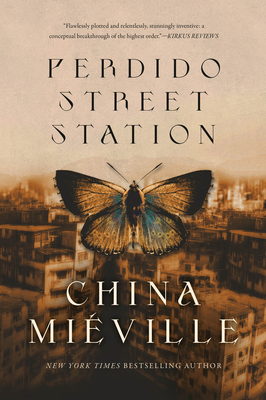This book blew my mind the first time I read it. I finished the whole thing while on flights for work in December of 2019. I’d never read anything quite like it.
Warning: minor spoilers ahead.
Before reading this book, I was convinced that there was an unspoken law that authors were not allowed to create strange new worlds with strange new characters at such a high volume. This novel is a license to create unabashedly. Though, I do feel that it is important to only do so if it serves the story. And China seems to do this.
There are a couple instances that I think were a bit much, but I still enjoyed it. The plot wouldn’t suffer the lack of the Handlingers. But then I would never have experienced a dog biologically strapped to a man as they fly, battling consciousness eating, interdimensional moths. Then there is the whole Jack Half-a-prayer character, which, I swear, is a setup for a pun that only arises in the closing sections of the book. He could have been played up more, but it still works. All these little details add to the complexity of the setting.
My flagged copy of Perdido Street Station
I also love how China ties in all these disparate threads. From the start the book introduces us to Yag, Lin, and Isaac. They each have their own distinct story arc. Yag comes to the city searching for a way to regain flight. Lin, an amazing artist, gets dangerously involved with a criminal kingpin. Isaac, after meeting Yag, is in search of a way to provide flight to Yag through his previous studies. His research unwittingly sets off the horrid events with the slake moths, not directly. This is something I love about this story. Things happen, then China shows us how things logically lead to other things, building to the climax of the story. All the threads–that of Yag, Lin, and Isaacs, as well as Derkan, the Construct Consol, Rudgutter, the Weaver, and so many more–all come together at the climax. I aspire to make all parts of my story important to the whole as China has done with Perdido Street Station.
Finally, I hope to absorb some of China’s skill with words. Unlike Bird Box and Come Closer, the prose of this book is very dense, and almost purple at times; but he gets away with it because it is different and engrossing. I did not care for the denser parts of Annihilation, but, for some reason, the prose of this one works for me. I have already started reading his next book in the series, and I plan to read much more of his work in order to understand his style. China is not afraid to slow the plot and ruminate on details; details that wouldn’t normally be interesting, such as how the mail system works in the government building, or an explanation of how physics and magic work together in the story universe on an analytical level.
I have learned a lot from this book, and that it still has so much more to teach me. I will be reading this again. Though, I may wait until after reading his other work first. I’m very interested to dive into his short stories and see how China’s style translates to shorter works.
